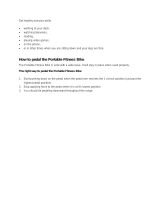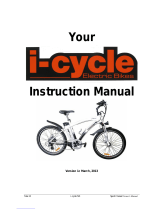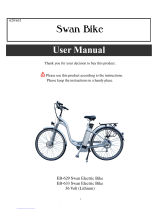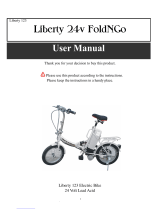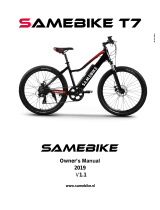Page is loading ...

Paris 36V 2019
User Manual
User Manual

2
Safety
When operating the Paris 36V please make sure you adhere to the following:
Always where a helmet when riding the Paris 36V
Always check your mirrors and blind spots when operating the vehicle.
Make sure that your battery power is suffi cient before you go out to ride
Obey all laws of the road.
Periodically charge the unit when not in use for long periods of time
If you bring your charger avoid shaking / rattling charger while riding
Do not over charge the battery by leaving the charger in the charging port. Once the
battery is fully charged remove the charger immediately.
Do not try to operate the unit while charging.
Do not let anyone uner the age of 16 years old operate this vehicle.
Do not make sharp / abrupt turns at high speeds to avoid tipping.
Do not operate under the infl uence of any use of drugs or alcohol
Do not completely submerge the unit in water
Do not operate in harsh weather conditions.
For any questions or concerns please call
1-800-649-9320 or visit www.daymak.com

3
About Daymak
Daymak is one of Canada’s largest Alternative Vehicle providers. We design, engineer, man-
ufacture, import and repair everything from recreational dirt bikes, go-karts and electric
golf cars to alternative transportation solutions such as e-bikes and gas scooters.
Our electric bicycles represent an energy-e cient and eco-friendly alternative for people
who need to get around the city. They greatly increase the practicality of bicycle transpor-
tation in urban centres. Costing only a few cents to charge, an e-bike can make city life
more convenient and much less expensive.
While there are many new Green technologies that are still in their infancy, electric bicycles
have been developing over the last 40 years or more. E-bike technology has been dramat-
ically re ned since the introduction of the rst custom-conversion bicycles. Today, electric
bicycles are a supremely reliable and a ordable means of transportation.
Daymak is constantly developing new eco-friendly alternative transportation strategies,
led by its own Research and Development department in Toronto, Canada. We are always
improving our products. Our innovative in-house engineering and quality testing provide
customers with many new kinds of reliable, eco-friendly vehicles, designed to help change
the lives of our customers and the world.
Daymak warranties, services, and stocks parts for everything it sells. We support our prod-
ucts.
Please feel free to visit our website. You’ll nd the latest in cool transportation solutions,
support for the products you’ve purchased and contact information.

4
Introduction
E-Bikes
Riding an electric bicycle is a great way to hop around town conveniently and cheaply. E-
Bikes represent a natural progression in the development of urban transportation.
Using only small amounts of electricity, e-bikes have the potential to radically reduce the
amount of pollution in our cities. As well, they are very quiet, so they do not add to the high
levels of noise pollution which we often take for granted. They are easy, and usually free,
to park. They are unobtrusive and highly practical additions to the urban landscape.
E-bikes are also inexpensive. They (currently) require no registration, no insurance, no li-
cence and do not incur parking charges. As well, compared to internal combustion en-
gines, the engines in electric vehicles have fewer moving parts and require far less main-
tenance.
Your Daymak e-bike is the result of Daymak’s years of experience, the highly trained tech-
nical skills of our sta and careful, ongoing design work by our engineers. We hope you
enjoy using this product and welcome any feedback that you may have.
New Laws
Most provinces in Canada, most states in the U.S.A, the United Kingdom and many Euro-
pean countries have new laws that permit cyclists to use electric motors to assist the reg-
ular operation of bicycles. Please check with your provincial or state government to learn
about your local laws. At the back of this manual you will nd the some of the common
Canadian provincial regulations that govern e-bikes.
Liability
Daymak does not assume any liability for damages, loss of pro ts, or claims from third
parties due to improper use of this product. Daymak does not assume any liability for dam-
ages due to problems with the product resulting from service by a third party that is not
certi ed by Daymak.
The information in this guide may be subject to change without notice. For the latest infor-
mation available, please contact your local Daymak dealer or visit our website.
We have taken all possible measures to ensure the accuracy and completeness of the in-
formation in this guide. However, if you do nd anything missing, incomplete or wrong, do
not hesitate to contact us.

5
Part Diagrams
Diagram 1: Paris 36V
This diagram illustrates the various parts of your ebike. Please note that many of these parts are not user-ser-
viceable and should be repaired only by trained professionals. This is especially true of the electrical systems
and the mechanical components.
1. Throttle
2. Brake
3. Basket
4. Headlight
5. Fender
6. Tire
7. Tire Pump Valve
8. Pedals
9. Kick Stand
10. Motor
11. Motor Lock
12. Rear Rack
13. Battery
14. Battery Lock
15. Bottle Holder
16. Display

6
Riding Instructions
This guide assumes that you already know how to ride a standard bicycle. Before you try to
ride an ebike, you should be very familiar with controlling and balancing a normal bicycle.
Caution
If you do not have cycling experience, an e-bike is too dangerous to ride. Do not begin
learning to ride a bicycle using an e-bike.
Important Notes
• Ebikes are Fast! E-bikes are capable of traveling at higher speeds than many bicy-
cle riders are accustomed to. Use caution at all times, especially when travelling
in mixed tra c. Always take into account driving and traveling conditions.
• Obey the Law. Be sure to follow all provincial and city tra c laws. This includes
obeying stop signs, checking carefully when turning, and riding defensively. An
e-bike is a motorized vehicle, even though it is classed as a bicycle. You must fol-
low the law.
• Stay Sober. Never ride your bicycle while intoxicated. An e-bike is capable of trav-
eling faster than a normal bicycle, and you should always be in control of it.
Items to Carry with the Electric Bike
It is a good idea to carry the following items with you at all times when you ride your e-bike.
• The charger, to charge the bike in case the battery power runs out
• A lock, to secure your e-bike when you park it
• A helmet, as required by safety laws

7
Inspecting your Electric Bike
Always inspect your e-bike before you ride it, to make sure its safety features are oper-
ating properly. Many accidents can be avoided with routine inspections. Once you are
comfortable with your e-bike, you will be able to detect small changes in the way it feels.
If anything changes between uses, make sure to have it properly examined. Also, be sure
to listen for changes in the sounds your e-bike makes over time. Any mechanical or power
issues may have e ects on the sounds the bicycle makes.
Holding the Handlebars
As with a normal bicycle or gas scooter, place your ngers over the brake levers, using the
palms of your hand and your thumbs to wrap around and under the handlegrips. Doing
this allows you to activate the brakes easily, by squeezing your hand, in case you have to
stop quickly. This is the safe way to control your electric bicycle.
Turning your E-bike On and Off
To turn on your e-bike, insert the key (if applicable) into the “ignition”, located just below
the dash board, and turn the key to the right. When your e-bike is activated, the power
indicator will light and the battery charge indicator will jump, showing you how much
power your e-bike has. To turn o the e-bike, simply turn the key to the left, and remove
the key (if applicable).
Warning
When you activate the e-bike, the electrical system becomes live. Do not try to a ect
changes to the E-Bike (such as removing the battery or repairing electrical components)
while the E-Bike is activated. Turn the E-Bike o and remove the key before you attempt
to access any of the electrical components. Also, the battery carries a signi cant electric
charge and can injure people if not treated properly and with respect.
Accelerating and Decelerating
The throttle is found on the right-side hand grip on the handlebars. Turn the grip forward
(towards you) to accelerate. To decelerate, release the grip (turn it away from you). Don’t
over-rotate the accelerator, as this could damage the battery and electrical components.
Warning
Do not activate the accelerator until you are seated on the bicycle and are ready to accel-
erate. The e-bike can easily escape from your control, possibly injuring you or others, and
the e-bike may be damaged by being dropped.

8
Stopping
Your e-bike has two sets of brakes, at the front and at the rear. The levers attached to the
handlebars, on the left and right, activate the brakes. Pull the levers toward you to activate
the brakes.
You can use both brakes to come to a stop more quickly, or you can use one of the brakes
to come to a gentle stop, depending on your riding needs at the moment.
When the brakes are activated, the power to the engine is automatically turned o , until
you release the brakes. This allows you to stop safely.
Safety Tips
• When you are traveling in wet weather, water may cause your brakes to function
less e ciently because it reduces friction between the brake pads and the wheels.
Take care to slow down and give yourself more room to stop or slow if necessary.
• It is a good idea to have your brakes and brake pads checked regularly. The brake
pads will eventually wear down through friction, and after signi cant use will have
to be replaced.
Signalling
Hand Signals
We recommend using your hand signals when you are turning.
Lights
The headlight and taillight are useful features when you are riding at night or in dark ar-
eas. They radically improve your safety in mixed tra c. The lights on your e-bike consume
some electricity. Keeping them on may reduce the maximum distance you can travel on
one charge by about 5 %.

9
Pedaling
This e-bike is designed to be a motor-assisted bicycle. You can use the motor by itself, but
ideally, you can work with the motor by pedaling. This increases the distance you can
travel on your e-bike, because it assists the motor and reduces the amount of electricity
you draw from the battery.
Riding in Wet Weather
Your e-bike is designed to function in wet conditions, such as when it is raining. However,
because the motor is on the rear wheel, it is easy to slip when moving at high speeds. If it
is very wet, be sure to avoid high speeds.
When you are traveling in wet weather, water may cause your brakes to function less ef-
fectively because it reduces friction between the brake pads and the wheels. Take care to
slow down and give yourself more room to stop or slow if necessary.
The Motor and Water
Your e-bike is not designed to be immersed in water. Always ensure that the water level
does not go above the middle of the tire, to prevent water from getting inside the motor.
Water in the motor can cause short-circuits and may damage the electrical systems in your
e-bike.
Riding in Cold Weather
Your e-bike is designed to operate year-round. However, in very cold conditions or when
there is a lot of snow or slush on the ground, it is possible for the motor in the e-bike to
get 10 degrees Celsius, the battery will not work as well as it would in warmer tempera-
tures. While Lithium-Ion batteries perform better than Lead-Acid batteries in temperature
extremes, both will experience reduced performance in cold temperatures.
Also, riding the e-bike in cold temperatures may require you to replace the battery sooner
rather than later.

10
Maximum Load
Do not exceed the maximum load capabilities of your e-bike. You can nd the exact load-
ing capacity listed in the technical speci cations in this guide.
If you exceed the maximum load, the performance of the bike will su er.
Exceeding the maximum load of your e-bike could cause damage to the shocks, to the
mechanism and, ultimately, even to the frame. It could also cause your motor to work too
aggressively, and it may burn out.
Long-Term Storage of your E-bike
If you are storing your bike for a long period, disconnect the battery. This is a safer way to
store the electric bicycle, as it prevents accidental activation of the e-bike and makes it
impossible to activate it even with the key.
Please see the section titled “Your Battery” for instructions on battery maintenance while
your e-bike is being stored.

11
The Battery
This section details what you need to know about the battery that powers your e-bike.
Always remember to treat your e-bike’s electrical systems with respect.
Battery Power
The battery has a charge indicator. When the e-bike is activated, the needle will jump and
indicate the currently available battery power.
If the power has dropped signi cantly, you should charge your e-bike.
Distance and Power
Your battery has the capacity to carry you anywhere from 35 to 60 km before it must be
recharged. The ability of your battery to power your bicycle depends on many variables.
These variables include the weight of the rider, the prevailing wind resistance, the rider’s
driving habits, the presence of steep hills and inclines, and other issues such as proper air
pressure in the tires.
Saving Power
If you are traveling long distances, you can save a lot of electricity by using better driving
habits:
• Coasting: When going downhill or over long, at road surfaces, try using your e-
bike’s momentum and allow it to coast, without drawing power from the motor.
• Stopping and Starting: Try to avoid stop and go movements. The motor draws
more power when starting from a full stop.
• Weight: Remove unnecessary weight from the bike. This reduces the amount of
power the motor must draw.
• Air Pressure: Make sure your tires have the proper air pressure. Proper pressure
reduces drag on the tires and radically increases the e ciency of any vehicle.
• Head and Tail Lights: Turn o the lights to conserve power, if it is safe to do so.
The lights will reduce the distance you can travel by about 5%.
• Pedalling: When accelerating from a full stop, you might want to try pedaling to
help acceleration

12
Charging your E-Bike
Charging your e-bike is a simple process. You require the following:
• The charger that came with your e-bike.
• A 110V household electrical outlet.
Charger Warning
Only use the chargers that were supplied with your e-bike. Using chargers that do not have speci cations
identical to those which came with the e-bike could irreparably damage your e-bike’s battery and electrical
systems, and may cause injury.
To charge your e-bike, follow these steps:
1. Turn o the e-bike and remove any key from the “ignition.” (when applicable)
2.Plug the female end of the charger cable into the charging slot on the e-bike.
This is found on the outside casing of the e-bike, in front of and just underneath
the seat.
3. Plug the male end of the charger power cable into your wall socket. This should
be a110v household electricity supply. You can also use a portable generator, if
necessary, but make sure it provides 110V current.
4. Allow the e-bike’s battery to charge for the appropriate amount of time (4-8
hours).
5. Disconnect the charger when the LED light on the charger is green. The batteries
have been fully charged.
If your charger’s LED status light does not change from red to green over an extended period of time, for
perhaps more than 12 hours, and the battery is very hot, the battery or charger may need replacing. Stop
charging and bring both to your Daymak dealer immediately. Do not charge the battery.
This is your charge port, plug your charger
into here and the other end into a 110V
outlet. Please note your battery does not
need to be in the bike for it to charge.

13
Battery Care
Follow these suggestions to maintain your battery’s optimal performance. If you do not
follow these suggestions, your battery may lose its ability to maintain a charge and might
have to be replaced sooner than would otherwise be necessary.
• Charge it: Charge your battery immediately after riding it.
• Full Charge: Do not allow the battery to run down completely and lie in storage
without a charge. This signi cantly reduces the battery’s lifespan and may cause
damage.
• Keep it Charged: When being stored, charge the battery occasionally to make sure
its power supply does not run down. Charging it once every 21 days should be
su cient.
• Storage Conditions: Store the battery on a at, cool, dry surface. Do not allow the
battery temperature to drop below 10 degrees Celsius for extended periods of
time.
Cold Weather and your Battery
Below 10 degrees Celsius, the battery will not work as well as it would in warmer tempera-
tures. While Lithium-Ion batteries perform better than Lead-Acid batteries in temperature
extremes, both will experience reduced performance in cold temperatures.
Also, repeatedly riding the e-bike in cold temperatures may cause your battery to have to
be replaced sooner.
Replacement and Disposal
A lithium-ion battery will last approximately 1000 charges. When the battery has to be
replaced, you will notice that your battery cannot carry as much of a charge as it could
initially.
Contact your local Daymak dealer to purchase a new battery.
When replacing your battery, dispose of it at a proper municipal battery recycling facility.
If none is available, please contact your local Daymak dealer.

14
Operation
Right Handlebar
On the right handle you will nd the throttle.
To engage the motor automatically without
pedalling. Turn the the throttle towards you
circled on the le to engage the motor.
Note for this to work your pedal assist must be
o and your machine must be on.
These are your brake levers, located on either
handle bar. Your left brake lever engages your
rear brake and your right brake lever engages
your front brake.
**Please note** Always engage your rear
brakes rst before applying your front
brake to avoid ipping.
Brakes
Throttle

15
Battery
Your battery is what powers your bike and
needs to be charged periodically a er riding.
1) Power Switch - Press this button to power on
your bike. On 1, the power will be given to the
bike on 0 there will be no power to the bike.
2) Charge Port - is is where you charge your
battery. Li up the cap to reveal the charge port.
is can be done in and outside of the bike
3) Battery Power Button - Press this to see how
much power is le in your battery, this can be
done connected or disconnected to the bike.
4) Battery Meter - Once the power is on, this
LED light will glow showing the amount of
power you have le .
Display
Your display on your le handle is what con g-
ures your pedal assist features.
1) Mode - Switch between levels of pedal assist
or throttle mode
2) PAS Level - is determines how much
automatic assistance the motor will provide you
as you pedal. If no level is lit up the throttle will
work instead.
3) Battery Meter - Once the power is on, this
LED light will glow showing the amount of
power you have le .
4) Light Switch - Press this to turn on and o
the front headlight.
5) ON / OFF - Press this to turn o all assis-
tance to the bike.

16
Inserting / Removing the Battery
Your batteries on your Paris 36V are removable! This allows you to charge the battery both inside
and out of the bike.
When putting in the battery in slide it at angle as seen below and the push it up until you hear it
clicks into place.
Once in place it will be locked and cannot be removed without a key. To remove the battery put
the key in the keyhole seen below and turn it clockwise while sliding out the battery at an angle as
you did to put it in.

17
Kickstand
The Paris 36V has a double kickstand that provides a stable way to stand your bike when not in
use. To use it lift the rear tire by the rear rack and with your foot push the stand downso it is per-
pindicular with the bike.
To take it o the kick stand push the lever shown below to the right and then lift the kickstand up
to its upright position.

18
Technical Data
This section provides you with the technical speci cations for your e-bike.
The Motor and Wheel Assembly
The Paris 36V has a 250 Watt magnetic DC brushless motor on the rear wheel hub. This type of motor has
excellent low-end torque and high e ciency when working within its range. Note that while the motor is
very quiet, it does produce some noise. Also attached to the rear hub are speed reduction gear and the
speed free clutch.
The Controller
Daymak pioneered the development of intelligent component control in e-bikes. The Daymak Drive tech-
nology developed by Daymak is the brain of your e-bike. It allows your e-bike to achieve faster acceleration,
to climb steeper hills, and to save energy.
The electronic controller is located under the seat assembly. This controller e ciently regulates the speed
and electronic functions of the bicycle. It allows for stepless speed adjustment, shuts o the motor when the
brakes are activated, has low voltage threshold.
The Brakes
The brakes on your e-bike are disc brakes, like those found on gas scooters and motorcycles. They generally
provide for very ne stopping and control. This is a very tested and well-designed technology, but even so,
the brakes will require servicing from time to time, and may have to be adjusted for tension.
Unlike normal friction-grip bicycle brakes, which clamp down from the outside, the drum brakes clamp from
the inside. When the brakes are activated, tension increases and the clamps engage. This is a very e ective
and reliable way to stop a vehicle.
The brakes are contained within a sealed unit, and are very nely adjusted and tted.
The Chain and Pedals
The pedals are connected to the rear wheel. Along with the chain, they provide a human- powered “drive
train”. This is an important part of your e-bike.

19
Maintenance and Troubleshooting
This section outlines problems you may have and solutions you may be able to use.
Many of the parts in this product are not user-serviceable and should be repaired by
trained professionals. This is especially true of the electrical systems and the mechanical
components. Alteration of these components voids the warranty.
Tire Pressure
Maintain the air pressure in your tires at the appropriate level. If the air pressure is too low,
your e-bike’s performance will su er and it will become damaged more easily.
Cold weather and lower temperatures will cause the air pressure in your tires to drop, and
warmer weather will cause it to increase, even if there are no leaks in the tire tube. To re-
place the air in your tires, follow this procedure:
1. Identify the required pressure by examining the text along the side of the tire
rim. This text should indicate the recommended pressure for your tire.
2. Locate the air valve on the inner surface of the tire rim.
3. Remove the valve cap and place in a secure location.
4. Place the nozzle end of an air pump (hand-power or mechanical) over the valve.
5. Pump up the air in the tire, being careful not to let the pressure go above the
level prescribed on the side of the tire wall.
6. Remove the pump nozzle from the air valve without allowing much air to escape
from the tire.
7. Replace the valve cap on the air valve.
Maintaining the proper air pressure will allow you to travel much further on a single charge,
because the motor will not have to work as hard to move the e-bike.
Replacing Flat Tires
Replacing at tire tubes is a more complicated and labour-intensive process with e-bikes
than it is with regular bicycles. It requires proper tools, more skill and more patience.The
front wheel is easier to service when changing a at tire than the rear wheel, as the rear
wheel is connected to the hub motor and other mechanical parts.
Unless you are very familiar with the mechanical components of the rear motor, attempt-
ing to change a at rear tire may cause serious problems. Please contact your Daymak
dealer for speci c instructions on how to remove your wheel and tires safely, and how to
replace the tubes.
It may be easier – and safer - to have the tubes replaced by your Daymak dealer.

20
The Motor
Do not service the motor yourself. Bring the e-bike to your Daymak dealer for service. The
motor in your e-bike is a highly complex and ne-tuned mechanism. Repairing it requires
signi cant expertise.
We suggest maintenance every 100 running hours or so.
The Chain
Ensure that the chain on your e-bike is well-oiled and lubricated. It is an important part of
your e-bike. As with any bicycle, it needs to be maintained if it is to function.
Shock Absorbers and Comfort
If your riding experience feels bumpier than usual, and you suspect that your shock ab-
sorbers are experiencing di culties, check the air pressure in your tires. If the air pressure
is too low, this may be the reason you feel less comfortable. It may have nothing to do with
your shock absorbers.
If the problem persists, take your e-bike to your Daymak dealer for servicing.
Bringing in your E-bike for Service
Do not attempt to service the electronic or mechanical parts of your e-bike unless you are
absolutely sure of what you are doing and have a solid understanding of electrical and
mechanical equipment.
If your e-bike is not performing properly, disconnect the circuit breaker and bring the
e-bike to your local Daymak dealer.
Do not store the e-bike without disconnecting the circuit breaker.
Liability
Daymak will not be held responsible for damage or injuries resulting from errors resulting
from improperly serviced parts.
/
